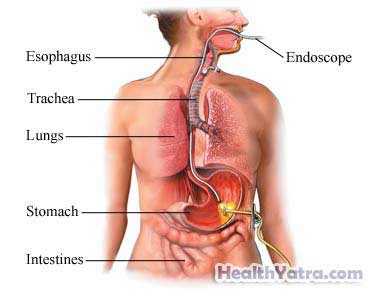Definition
Percutaneous endoscopic gastrostomy (PEG) is a procedure that places a tube through the abdominal wall and into the stomach.
Reasons for Procedure
A gastrostomy tube provides an alternative feeding site. It may be needed to:
- Feed a person who has a hard time sucking or swallowing
- Drain the stomach of fluids that have built up
Possible Complications
If you are planning to have a PEG, your doctor will review a list of possible complications, which may include:
- PEG tube malfunction
- Aspiration—accidental sucking into the airways of fluid, food, or any foreign material
- Damage to other organs
- Inflammation of the lining of the abdomen
- Infection
- Bloating
- Nausea
- Diarrhea
- Irritation of skin near the tube
- Death
Factors that may increase the risk of complications include:
- Obesity or diabetes
- Smoking
- Alcohol abuse or drug use
- Use of certain prescription medicines
- Prior abdominal surgeries
- Advanced age
What to Expect
Prior to Procedure
Your doctor may do the following:
- Physical exam
- Medical history
- Review of medicines
- Blood and urine tests
- X-rays of the abdomen
- Endoscopic examination of stomach—An endoscope is long tube with a camera at the end that can be put down the throat into the stomach.
Leading up to your procedure:
- Talk to your doctor about your medicines. You may be asked to stop taking some medicines up to one week before the procedure, such as:
- Aspirin or other anti-inflammatory drugs
- Blood thinners, such as clopidogrel (Plavix) or warfarin (Coumadin)
- Do not eat or drink for at least eight hours before the procedure.
- Arrange for a ride to and from the hospital.
Anesthesia
- Local anesthesia—usually a lidocaine spray to numb the throat
- Pain medicine is usually given through a vein in your arm
- Sedative—to help you relax
Description of the Procedure
You will be given antibiotics for the procedure.
An endoscope is a long thin tool with a light and camera. It will be inserted through your mouth, down your throat, and into your stomach. The camera will send images to a video monitor. The doctor will use the images to find the right spot to insert the PEG feeding tube.
A needle will be inserted through the abdominal wall and into the stomach at the chosen spot. Using the endoscope, the doctor will locate the end of the needle inside the body. A thin wire will be passed from the outside of the body, through this needle, and into the stomach. This wire will be grasped with a snare in the abdomen and pulled out through the mouth. There will be a thin wire entering the front of the abdomen, going into the stomach, and continuing up and out of the mouth. The PEG feeding tube will then be attached to this wire. The wire will be pulled back out from the abdomen. This will pull the PEG tube down into the body.
A small incision will be made in your abdomen. The tube will be pulled until the tip comes out of the incision in the abdominal wall. A soft, round bumper will be attached to the ends of the PEG tube. It will keep the tube secure. Sterile gauze will be placed around the incision site. The PEG tube will be taped to your abdomen.

How Long Will It Take?
30-45 minutes
Will It Hurt?
Anesthesia prevents pain during the procedure. You may feel some discomfort. For a couple of days after the procedure, you may have minor pain and soreness at the incision site. This may feel like a pulled muscle. Your doctor can prescribe medicine to relieve this discomfort.
Average Hospital Stay
The usual length of stay is one day. Your doctor may choose to keep you longer if complications arise.
Post-procedure Care
- When resting in bed, keep legs elevated and moving to avoid blood clots.
- Do not smoke.
- Take prescription pain medicine as instructed. Avoid taking aspirin or aspirin-containing products unless instructed otherwise.
- To promote healing, resume normal activities as soon as possible.
- Ask your doctor about when it is safe to shower, bathe, or soak in water.
- Be sure to follow your doctor’s instructions.
- Learn to feed yourself properly through the PEG feeding tube:
- You will receive fluids through an IV for a day or two. Then, you will start to get clear liquids through the PEG tube. If this works well, you will start a formula feed through the tube.
- A dietitian will teach you how to use your PEG tube. She will also teach you how to choose an appropriate tube-feeding formula.
- Remain upright for 30-60 minutes after eating.
- Learn the proper care of your PEG tube.
- Change the sterile gauze pads around the incision site regularly.
- Wash the PEG tube and the skin around it regularly to avoid infection.
- Learn how to empty your stomach through the tube.
- Learn how to recognize and handle problems like a blocked tube or a tube that falls out of place.
- Tape the tube site when it is not in use to prevent dislodging.
Call Your Doctor
After you leave the hospital, contact your doctor if any of the following occurs:
- Pain that you cannot control with the medicines you have been given
- Problems with the function of the tube or drainage around the tube
- Signs of infection, including fever and chills
- Redness, swelling, increasing pain, excessive bleeding, or discharge from the incision site
- Headaches, muscle aches, dizziness, or general ill feeling
- Nausea, vomiting, constipation, or abdominal swelling
In case of an emergency, call for medical help right away.
